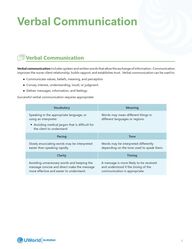
Return to flip book view
Message 1Verbal CommunicationVerbal CommunicationVerbal communication includes spoken and written words that allow the exchange of information. Communication improves the nurse-client relationship, builds rapport, and establishes trust. Verbal communication can be used to: ● Communicate values, beliefs, meaning, and perception ● Convey interest, understanding, insult, or judgment ● Deliver messages, information, and feelings Successful verbal communication requires appropriate:Vocabulary MeaningSpeaking in the appropriate language, or using an interpreter y Avoiding medical jargon that is difficult for the client to understandWords may mean different things in different languages or regions.Pacing ToneSlowly enunciating words may be interpreted easier than speaking rapidly.Words may be interpreted differently depending on the tone used to speak them.Clarity TimingAvoiding unnecessary words and keeping the message concise and direct make the message more effective and easier to understand.A message is more likely to be received and understood if the timing of the communication is appropriate.
VerbalCommunication2Communication LevelsIntrapersonal ("self-talk") ● Boosts positive self esteem and can improve abilities to care for clients ● Positive self-talk ○ eg, "I can do this! I have done hard things and I will do this now." ● Negative self-talk ○ eg, "This is too difficult for me. I can't do this."Interpersonal ● Direct, one-on-one communication ● Can occur face-to-face or via technology (eg, electronic, digital) ● Common type of communication for nurses ● Occurs among clients, family members, and the health care team small group ● Communication between two or more people ● Goal-directed and results in an outcome ● Involves group dynamics ○ eg, committees, staff meetings, client care conferences or support groups publIc ● In front of an audience ● Incorporates nonverbal communication with eye contact and body gestures ● Goal is to increase knowledge of the group or audience about a topic ○ eg, teacher presenting info at nursing conference or a community information program electronIc ● Using technology ● Client portals are used as a form of communication ○ eg, client can send and receive messages to and from the health care provider ● Requires proper etiquette for messages to be interpreted correctly ● Follow professional guidelines
VerbalCommunication3Circular Transactional Model of Communication (CTMC)Communication is ongoing and always changing when an interaction occurs. Each participant is a sender and receiver. Each participant is sending and receiving information because communication is a continuous cycle and the roles are always being transferred throughout the cycle of communication. The message being communicated is affected by context, environment and interpersonal variables.Encoding Decoding y Process of converting and sending information in a message. y Process of receiving and interpreting the message.
VerbalCommunication4Elements of CTMCElements of CTMC include:referent ● Encourages an individual to initiate communication with another individual ● It is a stimulus, such as a want, need, sound, or visual reference ● eg, a client who is asking "when will I be able to go home?" or a client who is in pain and asking for medicationsender ● Converts information (the need, motivation or stimulus), encodes it, then sends the message via verbal or nonverbal pathways receIver ● Receives the message from the sender, interprets the message, then decodes it into understandable information message ● Topic of communication ● An effective message is clear and presented to the receiver in a way that they can understand. ● The level of the client's understanding is important because this determines how the message should be communicated. ○ The message should not include terms that the receiver will likely not understand. ● The nurse should watch for nonverbal cues to confirm whether the receiver understands the message or whether information should be explained differently. ● The goal is for the client to completely understand the message being conveyed. channels ● Route or sense used for sending and receiving the message Visual Aural Tactile y Facial expressions, body language, medical record y What is said and heard (eg, verbal communication) ○ Tone, inflection, volume, and words used y Sense via touch (eg, touching a hot area) ● Communication is most effective when multiple channels are used (eg, teaching a student how to insert an indwelling urinary catheter) ○ Lecture alone ○ Lecture plus demonstration ○ Lecture, plus demonstration, plus practice
VerbalCommunication5feedback ● Communication from the receiver sent back to the sender ● Tells the sender how well the receiver has understood the meaning of the message Interpersonal varIables ● Involves the sender and receiver ● Variables affecting communication ○ May include culture, life experiences, values, beliefs, education level, physiologic state (eg, pain, adverse effects of medications, alertness and orientation) ● Nurses must have humility when communicating with clients to understand that what they are trying to communicate (ie, the message) may not be what the client is receiving. The nurse should make adjustments as necessary. envIronment ● Setting where communication is occuring ● Should be comfortable for everyone and free of distractions (eg, noise from other health care staff) ● An appropriate environment for the sender and receiver helps create effective communication for both.
VerbalCommunication6Check for Understanding 1The nurse is communicating with a client about pain control. Which of the following factors would interfere with a conducive environment for the conversation? Select all that apply.a) TV playing loudly in the room b) client is alone without distractions c) music playing on the client's phone d) interdisciplinary team is rounding with the client in the room e) family members present in the room, chatting and decoratingCheck for Understanding 2The nurses on the unit are discussing potential methods to reduce alarm fatigue. This is an example of which of the following levels of communication?a) public b) electronic c) small groupd) interpersonalCheck for Understanding 3Which of the following are considered an interpersonal variable in communication? Select all that apply.a) beliefsb) culturec) personal values d) educational level e) physiological stateAnswers1) a,c,d,e2) c3) a,b,c,d,e